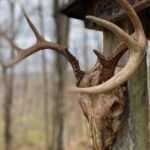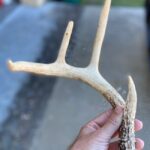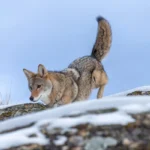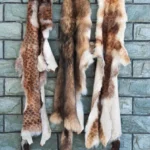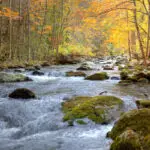Whitetail deer are beautiful, fascinating creatures, and seeing one in the wild can be an exhilarating experience.
However, spotting one during daylight hours is a lot rarer than one might think.
So what exactly are these elusive creatures doing during the night? What time of night are deer most active?
Table of Contents
- What Time Of Night Are Deer Most Active?
- Why Are Deer Most Active During The Twilight Hours?
- What Do Deer Do At Night?
- Do Deer Bed Down In The Same Place Every Night?
- What Time Of Night Does a Buck Come out?
- How Do You Find Deer At Night?
- Frequently Asked Questions
- Final Thoughts
- Related Posts
What Time Of Night Are Deer Most Active?
White-tailed deer are primarily crepuscular, meaning that they are most active during twilight hours, i.e., the very early morning hours leading up to dawn, and the afternoon hours leading up to dusk. These are the times in which deer are waking up for food (pre-dusk), and then later heading back to their bedding area for rest (pre-dawn).
Deer are considered to be crepuscular creatures, as opposed to being nocturnal, meaning they are most active during the twilight hours. Deer sleep most of the day and will take an opportunity to rest at night too.
Deer will sleep during the day before waking pre-dusk to feed. They will then use the cover of darkness to continue to feed throughout the night and/or pursue a mate.
Changing seasons, environmental conditions, habitat, and hunting pressures can all have an effect on a deer’s activity throughout the day. Poor weather conditions and the cold winter months are two factors that can limit a deer’s activity.
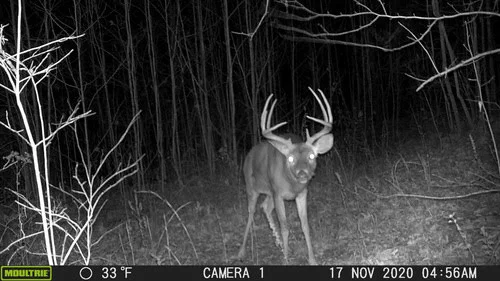
Why Are Deer Most Active During The Twilight Hours?
During main daylight hours, between 10 AM – 4 PM, most whitetail deer are usually sleeping. The hours pre-dusk are spent eating, before heading out further afield and the hours pre-dawn are spent eating again, before finding a safe place for bedding down.
When they wake, they get up to eat, sticking mainly around their bedding area where they feel safe.
They will then begin to move around and further out, looking for food and water sources. This is also the time when they will head out looking for a mate during the rut.
In the pre-dawn hours, deer will eat again and head back to their bedding area or begin searching for another safe space to sleep.
What Do Deer Do At Night?
Thanks to the cover of darkness, deer can inconspicuously feed throughout the night in an attempt to remain safe from hunters and predators. Bucks will also use this time to chase does and prepare to mate.
Oftentimes, you will find deer during the twilight hours around their bedding area eating, as this is the area where they feel safest.
They like to sleep near adequate food sources in places that offer good coverage. The darkness and foliage will help keep them hidden and safe from predators while they forage for food.
Deer eyesight works differently from humans. Deer are red-green colorblind, they have 330-degree peripheral vision, and their eyes lack a UV filter. They also have excellent night vision, thanks to the way the horizontal slits in their pupils act like an aperture on a camera, capturing the light and reflecting it back to the retina.
Their larger pupil openings increase light gathering ability to about nine times that of a human. This allows them to see better than us in low light! As a result of having excellent night vision, deer have the advantage over predators, at night, to safely move around.
Do Deer Bed Down In The Same Place Every Night?
White-tail deers are creatures of habit and prefer to bed in the same place over and over again. They are very cautious in selecting their bedding place so once they have found somewhere they will typically frequent this same area or surrounding territory.
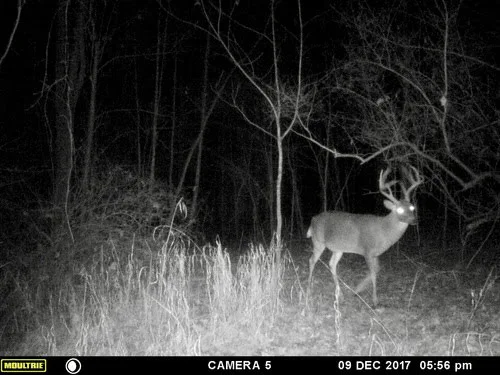
It is not uncommon to find deer in the same place over a series of days, weeks, or months if the place they have chosen offers them the right amount of coverage, comfort, and security.
Should an area be disturbed, or hunting pressures are high, the deer will move on to a new location, taking their time to find the right place.
What Time Of Night Does a Buck Come out?
A buck is most likely to leave its bedding area at dusk. However, a buck’s behavior will vary depending on weather conditions and the time of year, specifically if it is the time of the rut.
During the pre-rut, a buck will forgo food and rest in order to find a mate. This means they are more active at all times of the day and night and often behave more recklessly, increasing their visibility to predators and hunters.
How Do You Find Deer At Night?
So now that we know when deer are most active and what they are doing, how do we find them?
As we now know, deer are most active in the hours before dawn and before dusk, which offers a small window of opportunity during daylight for hunters, photographers, and wildlife enthusiasts to find deer during these times.
Follow these tips to help make your search for deer more successful:
- Know the area
- Be aware of the time of year
- Be conscious of the weather
- Find the deer’s bedding area without causing a disturbance
Local Area
Knowing your local area will help you find the local deer population. Popping into your local outdoor’s shop and asking where to find deer is always a good start.
Getting familiar with the terrain, the types of wildlife you are likely to encounter, knowing where the water sources are, and the species of deer that are local to you, are all important to have in your arsenal of knowledge.
Time Of Year
In states that experience harsh winters, you will likely see a change in deer activity patterns. During the winter months, deer are often spotted sleeping in the direct sunlight to trap the warmth in their fur coat.
Deer become more active in fall before the harsh winter weather sets in, as it is easier to find food in fall than in winter. This can mean they are out to feed for longer periods of time earlier in the day, and later in the morning, leaving them to sleep more at night.
White-tailed deer are significantly less active in the winter, significantly slowing their metabolism. This means they require less energy from food sources so they often will hunker down for days at a time, relying on fat stores.
Weather
Deer are very in tune with nature and weather patterns. If a storm is brewing the deer will know before you do. Changes in weather can mean changes in deer activity and patterns.
Deer tend to feed more actively before a storm hits and then bed down until it passes. If a big storm occurs during the night, you can often times find deer waiting it out or sleeping, having been more active in the daylight hours to feed.
Being conscious of any big storms approaching will allow you to get out and improve your chances of finding deer before they disappear at the change of weather.
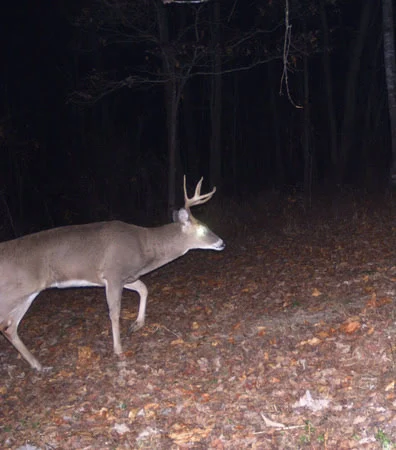
Bedding Area
If you can locate the bedding area of the deer (without leaving your scent or disturbing the area) there is a very high chance of you spotting the deer on its way back to rest or leaving to find its next meal.
Hunting At Night
Hunting for deer at night is illegal in most states so be sure to check your local legislation before setting out on a deer hunt. Hunting at night can be very dangerous so regardless of legalities, avoiding night hunting is a good idea.
Frequently Asked Questions
Are White-Tailed Deer Nocturnal?
White-tailed deer are considered to be crepuscular, as opposed to nocturnal, which means they are most active during the twilight hours.
Many species of deer are known for displaying nocturnal tendencies however, it is not uncommon to see them in the middle of the day when they are out with less risk of predators.
What Time Do Deer Feed?
As deer tend to sleep during the main daylight hours, waking a few hours before sunset is typically when they will be out foraging for food.
Their first priority when waking is to feed, so from around 4 PM-7 PM, is when deer will be eating around their bedding area not venturing too far.
They will continue to feed throughout the night before eating heavily again around sunset before bedding down again.
What Do Deer Do In The Day?
The question is then if deer are out eating and mating at night, what are they doing during the day? Well, the answer is mostly sleeping.
However, deer are unusual as their sleeping patterns vary according to their surroundings.
While it is known deer tend to sleep during the daylight hours, they do so with a heightened sense of awareness.
They will often aim to sleep in dense brush, covered from the sight of predators and hunters. But even while resting they remain very alert and able to move quickly, if needed, alerting other deer around them of any danger.
At night deer will also sleep for short periods of time, resting more easily during the day thanks to the protection darkness offers.
Final Thoughts
There you have it, deer are most active during the twilight hours, so whether you are looking for a perfect picture or the perfect shot, or maybe you just want to observe these animals in the wild, your best chance is pre-dawn and pre-dusk.
You May Also Like: Do Game Cameras Make Noise? And Do They Spook Deer?
